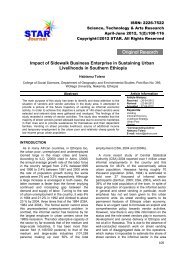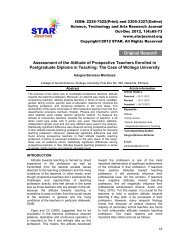Original Research Original Research - STAR Journal
Original Research Original Research - STAR Journal
Original Research Original Research - STAR Journal
You also want an ePaper? Increase the reach of your titles
YUMPU automatically turns print PDFs into web optimized ePapers that Google loves.
Tesfay Tolessa Bessa <strong>STAR</strong> <strong>Journal</strong>, July-Sep 2012, 1(3): 88-96Unlike the songs of the period, this is ironicaland its meaning is covered. It also indicated howthe Oromos were challenging the maladministration by using the language which wasconsidered shameful to speak in a public.After the major Oromo cultural show of the1977, songs and traditional dances werepopularized and were performed at every Oromogathering. The Oromo resistance againstoppression through songs of cultural groups hadgrown rapidly when different Oromo politicalparties got the support of the singers. The songswere either part of communal or personalcreations. It also served as a strategy of revivingOromo culture and language (Informants: MahadiMude, Mohammed Qophe, Zerihun Wadojo).In the attempt of addressing the Oromoquestions which were reverberating during theimperial regime, Darg permitted regular broadcastin Afaan Oromo. Singers were invited to broadcastthe songs that could expose the serious corruptionand exploitation which characteristics of theemperor’s regime. The songs were even made tohave the contents to educate, disseminate scienceand technology within the main stream ofsocialism.No less than the socialist propaganda, bydesign or default, the Oromo proverbs, folklores,songs, glories of culture and history which werebroadcast through the Oromo language massmedia inadvertently taught the people about theglories of their language, culture, and history. Thehistorical injustice, like the continuous aggression,suppression and exploitation inflicted on theOromo nation during the imperial regimes wererecited. Based on the examples of the radio, manyOromo began composing songs in the Oromolanguage for their kebele (village administration),Wored (sub district), Awraja (district) and Zonalmusical shows. (Informants: Mahadi Mude,Ibrahim Haji, Kebede Firisa).At the kabala level, the youth who wereorganized under the ideology of socialist Dargpropaganda began composing songs that praisedthe socialism in Oromo language. Dramas werealso prepared and presented at the annualanniversary of September 12. Sometimes suchsongs and dramas were broadcast over the radio.Many of the Oromo youth who were the membersof Abeyotawi Ken÷t (Revolutionary Troupe) wereable to write impressive types of songs andbecame the known singers from the Oromo nation.Those who heard the songs of their friends overthe radio attempted to do so by themselves (Ibid.).Thus, after these pioneer singers, many Oromomusicians had come to the scene and publicizedOromo culture, language, political consciousnessand others aspects of Oromo life to the world. Thesongs for the musicians were composed andorganized by Oromo elites. In connection with thisSahile Dagaagoo, Abubakir Musa, TesemmaNegeri, Mohammed Qophee and some othersplayed a leading role. In one way or another,almost all the songs composed in Oromo before1991 were directed towards the expression ofOromo life situation under the ruling classes. Thecovert implications of the songs were moresignificant than the overt. The singers braved topresent these songs to the masses under heavysecurity pressures. They attempted to reviveOromo culture, songs, and traditional danceswhich they performed and popularized at everyOromo gathering (Ibid.). Thus, the majority ofOromo songs during this period can becategorized as revolutionary songs.They became one of the rallying points in thedevelopment of written Oromo language literature.Many Oromo Youth made great efforts to recordsongs embodying political, cultural, and socialresistance against the policies of the Ethiopianregimes. Some such songs remained unpublishedeither because of strict censorship or because oflack of money. Informants report that many ofsuch songs are still in circulation in the hands ofmany people being copied into cassettes in theform of manuscripts. Some of them werepublished after 1991 and distributed to the peoplewho were interested to have them (Ibid.).Generally, since the beginning of singing inAfaan Oromo, two categories of Oromo singerswere emerged. The first group which constitutesthe largest members was the bands of extremenationalists. They took revolutionary songs asmajor instruments of fighting to manifest theirgrievances and to awaken the Oromo so that theystood for their rights. The second are those whoventured and were able to bear the politicalimpositions of the period and courageously sangOromo songs on the stages although theirmeasures were not from the Oromo nationalisticperspectives. Among such singers TilahunGesese was worth mentioning as he neverforgotten sing at least one Oromo song in all hisAmharic Cassettes. My informants even argue thatTilahun taught the possibility of singing veryinteresting songs in Afaan Oromo to the Ethiopianofficials beginning from the emperor’s period. Heattracted their attention to listen to entertainingAfaan Oromo songs together with that of Amharic(Ibid.). Producing or singing such songs was notwithout risky. When the Darg regime began facing95















